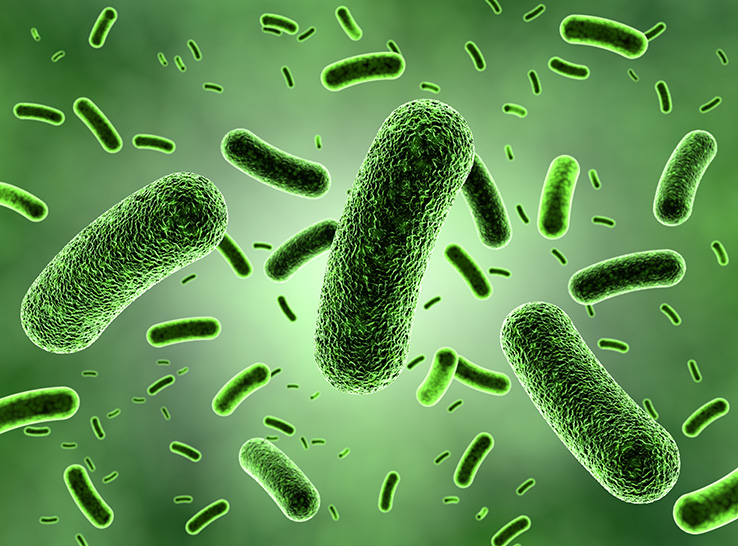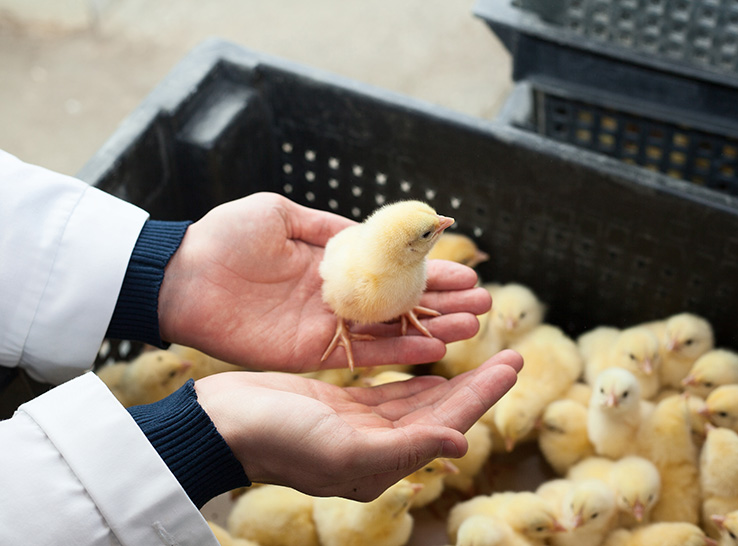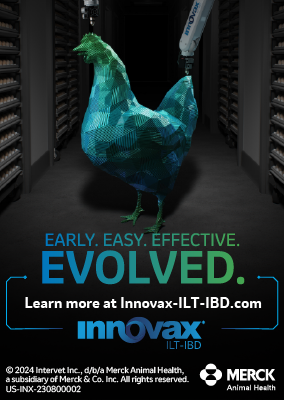First in a series
 Most poultry producers today use vaccines to help manage coccidiosis. Whether used year-round, seasonally or as part of a strategic rotation or bio-shuttle program with in-feed medications, the vaccines have proved to be valuable tools for protecting birds against the ubiquitous disease as long as they are managed effectively.
Most poultry producers today use vaccines to help manage coccidiosis. Whether used year-round, seasonally or as part of a strategic rotation or bio-shuttle program with in-feed medications, the vaccines have proved to be valuable tools for protecting birds against the ubiquitous disease as long as they are managed effectively.
As with any vaccine, proper storage, handling and administration are important. The process is especially critical with coccidiosis vaccines, which contain controlled, balanced doses of live coccidia organisms used to stimulate flock natural immunity.
Knowing the identity, concentration and shelf life of Eimeria organisms contained within the vaccine also is key to success.
“It’s important to note that immunity to one Eimeria species will not provide protection against another Eimeria species,” says Charlie Broussard, DVM, Merck Animal Health. “The challenge is getting every chicken in the flock to ingest sporulated oocysts from each species of Eimeria at about the same time.”
While chickens are susceptible to coccidial infection at any age, natural exposure typically occurs in the first 2 weeks after placement into a poultry house. Most Eimeria species require two or more life cycles in the bird to develop full immunity. Without a controlled vaccine exposure, the infection cycle can go on continuously, creating birds of different exposure status in a flock.
“It can be difficult for all birds to successfully consume the minimum dose needed to achieve full immunity quickly,” he notes. “Eventually, the entire flock will become exposed to coccidia, but faster flock immunity develops when there are more sporulated oocysts that are easier for the birds to find, and that’s where vaccines come in.”
Know your vaccine
Live coccidial vaccines are designed to uniformly infect birds with a controlled number of Eimeria oocysts to stimulate a protective immune response, but not all vaccines are the same.
For example, Merck’s Coccivac®-B52, intended for use in broilers, contains four species and five Eimeria strains, while Coccivac®-D2 is prepared from six species of coccidia and is designed for broiler breeder replacement pullets and egg-laying pullets.
“We build our vaccine to a consistent but minimal level for each species of Eimeria so that the vaccine has the same amount of sporulated Eimeria every time to initiate the first infection,” Broussard says.
The Eimeria lifecycle is about 7 days, with the first 5 days an asexual period and the next 2 days as sexual reproduction, producing high numbers of oocysts. “ Initially, the oocysts are not infective. To become infective or sporulated, oocysts require moisture and heat. That takes about 48 hours in a chicken house,” he notes. “Then it takes two to three exposures to each coccidia species to achieve full immunity, which will last for the life of the bird.”
Because the vaccine is formulated to a minimal level for each Eimeria strain, it’s important to follow the recommended dosage exactly. “It’s extremely critical that people don’t cut the dose on any coccidial vaccine because with mass application of these vaccines, some birds may not get enough antigen in the in the initial uptake,” Broussard says. “All coccidial vaccines contain minimal infective levels of coccidia to get the process started.”
Also, pay attention to vaccine dating, which relates to the viability of the oocysts, and not all vaccines are created equal. Some have a short 6-month shelf life while others will be 12 months or longer. “Our Coccivac-B52 vaccine has a 12-month shelf-life,” he points out. “The high Eimeria antigen content collectively and per species provides more viability and a long shelf life.”
1. Storing and handling
The success of a coccidial vaccination program starts with quality, healthy chicks but also depends on proper vaccine storage, handling and administration. Live coccidial vaccines are formulated to provide controlled exposure to the bird through a specific dose of live sporulated oocysts, and these oocysts are sensitive to environmental conditions, especially temperature.
Live vaccines should be stored at temperatures between 35° F to 46° F (2° C to 8° C). It’s wise to monitor refrigerator temperatures to ensure they never approach freezing as that will damage sporulated oocysts and reduce the vaccine’s effectiveness. “Never use a vaccine if there is any evidence of accidental freezing,” Broussard says.
2. Ensure uniform administration, ingestion
The objective of a live coccidial vaccine program is to ensure all birds in a house begin cycling the oocysts at the same time, which allows immunity to develop uniformly. This is dependent on chicks at the hatchery receiving uniform vaccine coverage and ingestion.
Inadequate vaccination occurs when the vaccine is improperly mixed, there’s poor spray coverage or equipment malfunctions.
“Those unvaccinated chicks will be naïve to coccidia after placement and will receive their initial exposure from field strains or first-cycle vaccinal oocyst output from flockmates,” Broussard notes. “Such uncontrolled dose exposures can overwhelm some birds and may result in excessive reactions early in the life of the flock.”
To further ensure uniform coverage of Coccivac vaccines, the Spraycox® application system was developed to accommodate hatchery design and chick processing volumes.
3. Hatchery spray procedures
In the hatchery, spray-cabinet systems such as Spraycox deliver a uniform vaccine dose by coarse spray for each box of 100 chicks. To ensure consistent dosage, check the equipment daily for proper volume calibration and spray pattern.
Adding a red dye to the vaccine encourages preening among the chicks and helps ensure distribution of the vaccinal oocysts. It’s important to use a dye recommended by the vaccine’s manufacturer to ensure compatibility. “Some coloring agents may be harmful to the sporulated oocysts in the vaccine,” Broussard notes.
Following a proper vaccination, chicks will be slightly damp with an even red coloring. They will begin to clean, dry and oil their feathers. “This preening behavior should be encouraged, since it is how the chicks will ingest the oocysts,” he adds.
During this time, hatchery holding rooms should be well-lit and maintained at temperatures that support chick comfort and encourage preening behavior. Allow at least 15 minutes for chicks to preen and their feathers to dry.
4. Gel considerations
Another option when vaccinating chicks in the hatchery is to use a gel diluent. These gel droplets tend to lie on the surface of the feathers. The use of the gel is something of a personal preference.
“No differences in bodyweight gain or protection were observed from challenge between birds vaccinated using coarse spray, high-viscous gel, low-viscous gel or via gavage with Coccivac-B52,” Broussard says. “Regardless of the diluent, what’s important is that oocysts reach the chicks at the right dosage in a uniform manner.”
There are a few considerations worth noting for gel diluents. The carrying capacity of a gel droplet is dependent on its size, as large droplets contain more oocysts than small droplets. The type of coccidial vaccine administered via gel influences the number of oocysts per milliliter required, so check with the supplier. Effective gel application relies on uniform mixing, especially if respiratory vaccines are included.
5. Feed-spray application
There may be times when hatchery application of a coccidiosis vaccine is not possible or a batch of chicks was overlooked. In these cases, feed-spray application can be an effective alternative.
“The goal is to achieve uniform ingestion of vaccine oocysts through feed, which will require proper application technique and good brooding management,” Broussard says. “It’s especially important that the birds are in a comfortable environment and able to consume feed uniformly.”
To determine the timing of on-feed vaccination, consult the flock veterinarian or the vaccine supplier’s technical service representatives. Mix the vaccine thoroughly and transfer it to a clean, garden-type pressure sprayer designated for vaccine use only. To prevent oocysts from settling in the solution be sure to keep the vaccine agitated throughout the spraying process.
Use half of the diluted vaccine volume to uniformly cover the surface of feed in feed lids, brooding paper and feed pans. All feed available to the chicks should be covered with vaccine, which will darken the feed surface. The feed should be damp, not wet.
Once coverage is complete, repeat the process with the remaining volume of diluted vaccine. The feed should be dry enough to allow the vaccinator to see the feed darken with the second application. Two complete passes over the feed will improve coverage uniformity. Finally, allow chicks enough time to consume the vaccinated feed before placing more feed in feed lids, on the paper or in the pans.
There are a few other steps to consider for this process, Broussard points out. Do not withhold feed or vaccinate chicks first thing in the morning, as this encourages more aggressive chicks to overeat, leaving no oocysts on the feed surface for the rest of the flock. Do not medicate drinking water or use water disinfectant during vaccination or 24 hours before or after application.
Monitor the birds’ post-vaccination reaction, and if there is a concern, contact the flock veterinarian.
Bottom line, if used properly and the chickens are exposed to an appropriate dose of coccidial vaccine, they will be protected regardless of vaccine application method.
For more tips and insights for managing coccidiosis, click here.
Other articles in this series:
Coccidiosis vaccination: Are you creating an environment for success?
Managing feed, water critical for coccidiosis vaccination success
Veterinarian offers tips for monitoring effectiveness of coccidiosis-vaccination program
Coccidiosis vaccine checklist: Tips for maximizing performance
Editor’s note: Content on Modern Poultry’s Industry Insights pages is provided and/or commissioned by our sponsors, who assume full responsibility for its accuracy and compliance.









